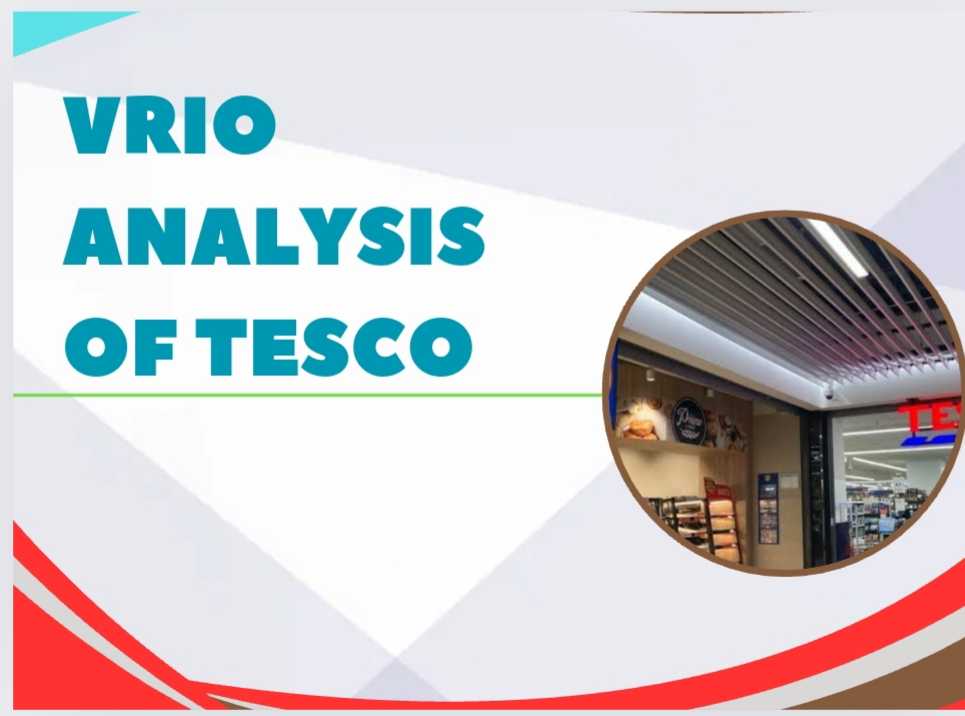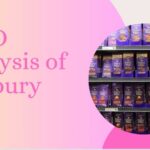In the highly competitive retail landscape, Tesco stands out as one of the foremost players in the industry, thanks to its extensive network and innovative approach. A VRIO (Value, Rarity, Imitability, Organization) analysis of Tesco offers a comprehensive framework to evaluate the company’s strategic resources and capabilities. By examining how Tesco’s assets and competencies contribute to its competitive advantage, we can better understand the company’s success and sustainability.
This analysis will delve into the unique elements of Tesco’s operations, such as its supply chain efficiency, technological advancements, and brand equity, to assess how these factors enable Tesco to maintain its leadership position in the market.
Table of Contents
ToggleValue in VRIO Analysis of Tesco
In the context of the VRIO framework, “Value” refers to the ability of a company’s resources and capabilities to create value for customers and contribute to competitive advantage. For Tesco, several key factors illustrate how its resources and capabilities are valuable:
1. Extensive Retail Network
Description: Tesco operates a vast network of stores, including hypermarkets, supermarkets, and convenience stores across multiple countries.
Value: This extensive presence allows Tesco to serve a broad customer base efficiently. It enhances the company’s ability to offer a wide range of products and reach consumers in various locations, contributing to increased market share and revenue. The convenience and accessibility of its stores are significant value drivers, meeting diverse customer needs effectively.
2. Advanced Supply Chain Management
Description: Tesco has invested heavily in creating an efficient supply chain system. This includes sophisticated logistics, inventory management, and supplier relationships.
Value: Efficient supply chain management ensures that products are available when and where customers want them, reducing stockouts and excess inventory. This capability lowers operational costs and enhances customer satisfaction. By optimizing its supply chain, Tesco can offer competitive pricing and maintain product quality, which are crucial factors in attracting and retaining customers.
3. Clubcard Loyalty Program
Description: Tesco’s Clubcard is a loyalty program that rewards customers with points on their purchases, which can be redeemed for discounts or rewards.
Value: The Clubcard generates valuable customer data that Tesco uses to analyze shopping behaviors and preferences. This insight allows Tesco to personalize promotions, optimize inventory, and enhance the shopping experience. The loyalty program not only drives repeat business but also provides Tesco with a competitive edge by fostering deeper customer relationships and increasing brand loyalty.
4. Technological Integration
Description: Tesco has integrated technology into various aspects of its operations, including online shopping platforms, digital payment systems, and data analytics.
Value: Technological advancements enable Tesco to offer a seamless omnichannel experience, blending physical stores with online shopping. This integration improves convenience for customers, supports personalized marketing, and streamlines operations. Technology also enhances efficiency in areas such as inventory management and customer service, contributing to cost savings and improved customer satisfaction.
5. Strong Brand Reputation
Description: Tesco has built a strong brand reputation over decades, known for its value, reliability, and extensive product range.
Value: A strong brand reputation attracts and retains customers, driving sales and fostering trust. Tesco’s brand strength supports its market position and differentiates it from competitors. Consumers often choose Tesco for its perceived reliability and quality, which enhances customer loyalty and helps the company maintain a competitive advantage.
Tesco’s resources and capabilities are valuable in multiple ways, from its expansive retail network and advanced supply chain management to its Clubcard loyalty program and technological integration. These factors collectively contribute to the company’s ability to deliver exceptional value to customers, drive revenue, and maintain a competitive edge in the retail sector. By continually leveraging and enhancing these valuable assets, Tesco reinforces its market position and ensures its long-term success.
Rarity in VRIO Analysis of Tesco
1. Extensive Global Network
Description: Tesco operates a vast and diverse network of stores, including hypermarkets, supermarkets, and convenience stores, across multiple countries, particularly in the UK and Europe.
Rarity: While other retailers also have large networks, Tesco’s extensive reach and variety of store formats are distinctive. Its ability to manage such a broad portfolio efficiently, with significant market penetration in key regions, sets it apart from many competitors. The scale and scope of Tesco’s retail network are rare and provide it with significant competitive advantages, including economies of scale and comprehensive market coverage.
2. Advanced Supply Chain and Logistics
Description: Tesco’s supply chain system is highly sophisticated, involving advanced logistics, real-time inventory management, and strong supplier relationships.
Rarity: While many large retailers invest in supply chain efficiencies, Tesco’s supply chain capabilities are particularly advanced and rare in their level of integration and effectiveness. The company’s ability to execute just-in-time inventory management and maintain high standards of efficiency across such a vast network is not easily replicated. Tesco’s supply chain innovations, including the use of automated systems and advanced forecasting techniques, give it a unique advantage in the industry.
3. Clubcard Loyalty Program and Data Analytics
Description: Tesco’s Clubcard loyalty program provides customers with rewards and collects detailed shopping data.
Rarity: Although many retailers have loyalty programs, Tesco’s Clubcard stands out for its scale and integration with data analytics. The depth of data collected and the sophistication with which Tesco analyzes this data to tailor marketing and improve customer experiences are rare. This capability allows Tesco to offer highly personalized promotions and optimize its inventory in ways that many competitors cannot match.
4. Technological Innovations
Description: Tesco has been a pioneer in integrating technology across its operations, including online shopping, digital payment systems, and supply chain automation.
Rarity: Tesco’s technological innovations, particularly its early adoption of online retail and its investment in digital infrastructure, are rare in their breadth and impact. The seamless integration of technology into both its physical stores and online platforms enhances the customer experience and operational efficiency in ways that are not easily duplicated by competitors. Tesco’s early and continued investment in technology provides it with a unique position in the market.
5. Strong Brand Equity
Description: Tesco has developed a strong, well-recognized brand that stands for value, reliability, and a wide range of products.
Rarity: While many companies have strong brands, Tesco’s brand equity is particularly rare due to its long history, extensive market presence, and broad customer base. The brand’s recognition and reputation for quality and value, built over decades, are difficult for competitors to replicate. Tesco’s brand strength supports its market leadership and fosters customer loyalty.
Tesco’s resources and capabilities that are deemed rare include its extensive and diverse global network, advanced supply chain and logistics systems, sophisticated Clubcard loyalty program and data analytics, pioneering technological innovations, and strong brand equity. These rare attributes contribute significantly to Tesco’s competitive advantage, setting it apart from many of its rivals and reinforcing its dominant position in the retail industry. By continuing to leverage and build upon these rare resources, Tesco enhances its ability to maintain a leadership role in the market.
Imitability in VRIO Analysis of Tesco
1. Extensive Global Network
Description: Tesco’s extensive network of hypermarkets, supermarkets, and convenience stores spans multiple countries, giving it significant market reach.
Imitability: While establishing a large retail network is theoretically possible for competitors, replicating Tesco’s network is challenging due to the substantial investment required in real estate, logistics, and infrastructure. The time needed to build a network of this scale, coupled with the complex logistical and operational systems that have been developed over decades, makes this network difficult for competitors to imitate quickly.
2. Advanced Supply Chain and Logistics
Description: Tesco has developed an advanced supply chain and logistics system that includes real-time inventory management, automated distribution centers, and strong supplier relationships.
Imitability: The sophistication of Tesco’s supply chain is not easily imitable. The company’s logistics operations are supported by proprietary technologies and processes developed over years of optimization. Competitors would face significant challenges in replicating this level of efficiency due to the high capital expenditure required, the complexity of the systems, and the deep integration with Tesco’s overall business model. Additionally, the expertise and experience Tesco has accumulated in managing its supply chain are valuable and not easily transferable.
3. Clubcard Loyalty Program and Data Analytics
Description: Tesco’s Clubcard loyalty program is supported by extensive data analytics that provides personalized offers and insights into customer behavior.
Imitability: While other retailers can create loyalty programs and utilize data analytics, replicating the scale and effectiveness of Tesco’s Clubcard is more difficult. The value lies not only in the technology but also in the depth of data collected over years and the sophisticated analytics developed to interpret this data. Competitors would need to invest heavily in similar technologies and data collection systems, and even then, replicating the historical data and established customer relationships would be challenging.
4. Technological Innovations
Description: Tesco has been a leader in integrating technology across its operations, including online shopping platforms, digital payment systems, and supply chain automation.
Imitability: Technological innovation is inherently replicable to some extent; however, the way Tesco has implemented and integrated these technologies is complex. The company’s early adoption and continuous investment in cutting-edge technology create a high barrier to imitation. Competitors may adopt similar technologies, but achieving the same level of integration and effectiveness requires significant investment, time, and expertise, making it difficult to fully replicate Tesco’s technological advantage.
5. Strong Brand Equity
Description: Tesco’s brand is associated with value, reliability, and a wide range of products, established over decades.
Imitability: Building strong brand equity is a lengthy and challenging process. Tesco’s brand reputation has been built over many years through consistent service, quality, and customer engagement. While competitors can attempt to build their own brand equity, replicating Tesco’s established market position and customer trust is a formidable task. The historical investment in brand building and customer relationships provides Tesco with a durable advantage that is not easily imitable.
Tesco’s resources and capabilities present varying degrees of imitability. Its extensive global network, advanced supply chain, and sophisticated Clubcard loyalty program are particularly challenging for competitors to replicate due to the significant investment, time, and expertise required. Technological innovations and strong brand equity also contribute to Tesco’s competitive advantage, though they are not entirely immune to imitation. Overall, Tesco’s ability to maintain its lead in the market is supported by its unique and complex resources and capabilities that offer substantial barriers to replication by competitors.
Organization in VRIO Analysis of Tesco
1. Operational Structure and Management
Description: Tesco’s organizational structure is designed to support its vast and diverse operations. The company employs a hierarchical structure with well-defined roles and responsibilities across its various divisions, including retail operations, supply chain management, and technology.
Organization: Tesco’s ability to efficiently manage its large-scale operations is a testament to its well-organized structure. The company’s management practices ensure clear communication and coordination across its global network of stores. This effective organizational structure allows Tesco to implement strategies consistently across different markets, manage its extensive supply chain, and respond swiftly to market changes. The alignment between organizational structure and business strategy enables Tesco to leverage its resources effectively.
2. Strategic Planning and Execution
Description: Tesco employs comprehensive strategic planning processes to guide its operations and growth. The company’s strategic initiatives are driven by a clear vision and objectives, focusing on innovation, customer satisfaction, and market expansion.
Organization: Tesco’s ability to execute its strategic plans is supported by its well-established organizational processes. The company’s leadership team develops and communicates strategic goals, while various departments and teams work collaboratively to achieve these objectives. The alignment of strategic planning with operational execution ensures that Tesco’s resources are utilized effectively to drive growth and maintain competitive advantage. The company’s structured approach to strategy implementation helps in adapting to market trends and competitive pressures.
3. Technological Integration and Innovation
Description: Tesco’s investment in technology includes advanced IT systems, digital platforms, and data analytics tools. The company integrates these technologies across its operations to enhance efficiency and customer experience.
Organization: Tesco’s organizational capability to manage and leverage technology is evident in its seamless integration of digital tools with its retail operations. The company has established dedicated teams and departments to oversee technology deployment and innovation. This structured approach allows Tesco to stay at the forefront of technological advancements and use these innovations to improve operational efficiency and customer engagement. The effective organization of its technological resources contributes to its competitive edge.
4. Customer-Centric Approach
Description: Tesco places a strong emphasis on customer satisfaction and loyalty. Its organizational processes are designed to gather customer feedback, analyze preferences, and tailor offerings to meet customer needs.
Organization: Tesco’s customer-centric approach is supported by its organizational systems that focus on understanding and responding to customer demands. The company uses data from its Clubcard loyalty program and other sources to drive decisions related to product offerings, promotions, and store layouts. The integration of customer insights into strategic and operational decisions ensures that Tesco can deliver a personalized and satisfactory shopping experience. This organizational capability enhances customer loyalty and reinforces Tesco’s market position.
5. Talent Management and Employee Development
Description: Tesco invests in employee training and development to ensure that its workforce is skilled and capable of driving the company’s success. The company offers various programs for career development and performance management.
Organization: Tesco’s organizational emphasis on talent management ensures that its employees are well-equipped to handle their roles and contribute to the company’s objectives. The structured approach to employee development includes training programs, performance reviews, and career progression opportunities. By fostering a skilled and motivated workforce, Tesco enhances its ability to execute its strategies effectively and maintain high standards of service and operational efficiency.
Tesco’s organizational capabilities play a crucial role in leveraging its valuable, rare, and hard-to-imitate resources. The company’s effective operational structure, strategic planning and execution, technological integration, customer-centric approach, and talent management practices all contribute to its competitive advantage. By organizing its resources and capabilities efficiently, Tesco is able to maintain its leadership position in the retail sector and continue to adapt to evolving market conditions and consumer preferences.


